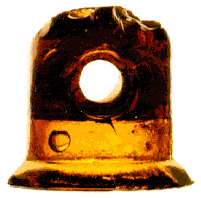
 |
Lightning Rod Insulators (LRI's) |
To see a nice assortment of lightning rod insulators from North America, take a look at these photographs.
The idea of lightning rod insulators was to separate the structure from the "electric fluid" of lightning being carried down the rod. The small glass insulator was to hold off the charges from the house.
The earliest reference to LRI's appeared in 1848. These were advertised by James Spratt of Cincinnati, Ohio. (thanks Glenn Drummond). It is possible that they were in use earlier, especially up in New England. I'd say that glass ones lasted until the 1900-1910 era. Porcelain LRI's were also used. They date from about 1900-1940 or so.
I know of some 130+ glass LRI shapes (as I define them!!), and maybe 20-30 porcelain shapes.
Glass LRI's come in most all the same colors as pin-type insulators do! Like: clear, straw, peach, grey, SCA, purple, royal purple, milkglass, green, olive, jade, yellow-green, olive blackglass, emerald green, lime, cornflower blue, cobalt blue, light cobalt, teal, ink, rootbeer amber, honey amber, blackglass, greenish amber, ginger ale, puce, etc., etc.!!
LRI's were usually mounted on small iron (or sometimes bronze, copper, or galvanized iron) brackets on the building sides and roof. On the oldest systems, the rod ran from ground up to six or so feet above the roof. There was no rod running across the roof. Later systems had tall stands called "braces". These were three or four feet tall, and sat on the roof peak; the lightning rod ran up through this brace. Many of these braces had glass or porcelain LRI's on them.
![]() Return to the Insulator Go-with's
page
Return to the Insulator Go-with's
page
Please send your questions and comments to Jim Colburn,
Last updated Sunday, May 12, 1996